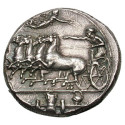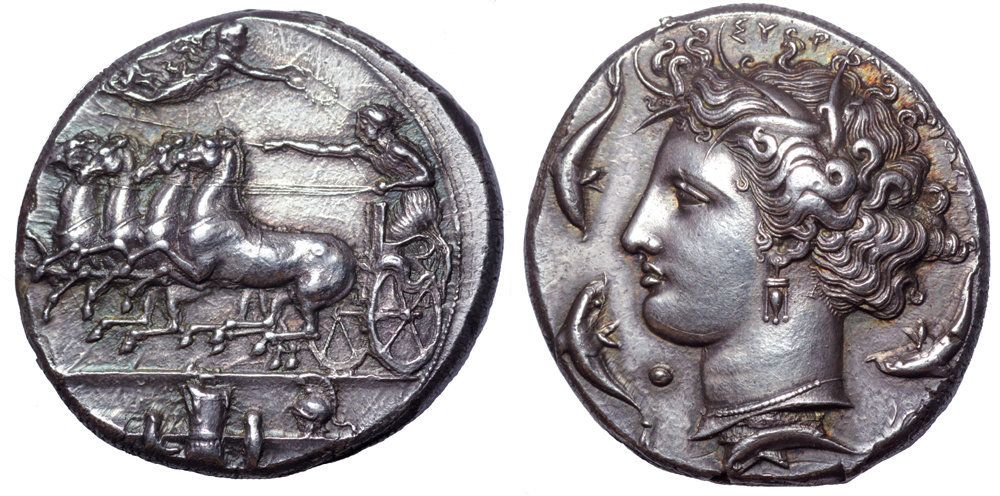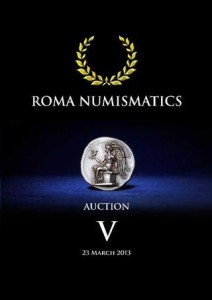A Scion Society of The Baker Street Irregulars

Syracusan — Of The Best Period
As he stood in front of us now, he held a piece of chamois leather in his right hand with which he was polishing a coin. “Syracusan — of the best period,” he explained, holding it up. “They degenerated greatly towards the end. At their best I hold them supreme, though some prefer the Alexandrian school.”
– The Adventures of The Three Garridebs (3GAR)
 I imagine that many of you shuddered, as I did, when reading the passage about polishing a coin….. We don’t know exactly what Syracusan (Syracuse was located in the modern day Sicily) coin it was that Nathan Garrideb was polishing in his hand on that fateful day when Holmes and Watson called upon his lodgings. I like to think that coin is the one pictured above, a decadrachm of Dionysios I, struck around 400-370 BC. The coin is of a meaningful size and features a very detailed design.
I imagine that many of you shuddered, as I did, when reading the passage about polishing a coin….. We don’t know exactly what Syracusan (Syracuse was located in the modern day Sicily) coin it was that Nathan Garrideb was polishing in his hand on that fateful day when Holmes and Watson called upon his lodgings. I like to think that coin is the one pictured above, a decadrachm of Dionysios I, struck around 400-370 BC. The coin is of a meaningful size and features a very detailed design.
 The coin pictured above was lot 123 in Auction V, conducted by Roma Numismatics, Ltd. on March 24, 2013. The presale estimate was for the coin was 75,000 GBP. The coin sold for 90,000 GBP, the equivalent of over $130,000 USD. The full lot description is below:
The coin pictured above was lot 123 in Auction V, conducted by Roma Numismatics, Ltd. on March 24, 2013. The presale estimate was for the coin was 75,000 GBP. The coin sold for 90,000 GBP, the equivalent of over $130,000 USD. The full lot description is below:
Sicily, Syracuse AR Dekadrachm. Time of Dionysios I, circa 400-370 BC. Charioteer driving galloping quadriga to left, holding kentron in right hand, reins in left; above, Nike flies to right, a wreath in her outstretched arms to crown the charioteer; in the exergue, a panoply of arms is set on two steps: a cuirass, two greaves, and a Phrygian helmet / Head of the nymph Arethusa to left, wearing a reed wreath, triple-pendant earring, and a pearl necklace; below her chin, a pellet, ΣΥΡΑΚΟΣΙΩΝ behind, four dolphins playing around her. Gallatin V-XXII (five examples recorded from this pair of dies); Dewing Coll. 923 (same obverse die). 43.38g, 36mm, 5h.
Good Extremely Fine.
Ex Rarcoa auction, CICF 1985, lot 10 and coverpiece, from the estate of a Chicago collector who had owned it for forty years.
The dekadrachms of Syracuse have been called ‘the admiration of the ancient and modern world’, and ‘perhaps the most famous of all ancient coins’; rightly so, for by virtue of not only their impressive size and weight, but more importantly the incredibly detailed artistry of exquisite style which they bear, they represent the zenith of cultural and numismatic technological achievement at ancient Syracuse, and are among the most beautiful coins ever struck for circulation.
Produced at the apex of Syracuse’s power and glory, the dekadrachm issue began circa 405 BC, following the election of Dionysios as supreme military commander of Syracuse for his achievements in the war against Carthage, and his subsequent seizure of total power. Syracuse had only recently defeated an Athenian invasion of Sicily that resulted in the utter destruction of Athens’ expeditionary force and ultimately contributed significantly to Athens’ defeat at the hands of Sparta in the Peloponnesian War. Then under Dionysios in 405, despite the ruin of great cities such as Akragas and Gela, Syracuse repulsed a Carthaginian invasion that might have resulted in a complete conquest of the island. Such glory was short-lived however, as the rule of Dionysios’ son and successor was to bring only civil strife that would weaken the power of Syracuse. Never again would the city issue coinage on such a grand scale, and with the cessation of tetradrachm production in c.400 BC, the dekadrachms represent the last great flourishing of classical numismatic art at Syracuse before two centuries of steady decline and eventual conquest at the hands of the Romans.
This astounding example is struck from the freshest dies with uncommon precision, and has been preserved in near mint state, such that the level of detail is virtually unparalleled. Features such as the delicate folds and pleats in the chiton of the charioteer, her facial details, and the manes of the horses are very rarely encountered with this level of sharpness and clarity. A truly stunning and choice specimen of the Euainetos series.

[…] Every member of The Fourth Garrideb receives a Garrideb Decadrachm with their lifetime membership certificate, an homage to the Baker Street Irregulars and their shillings. For the Sherlockian with a spare $40,000 – $50,000, there is a chance to acquire a real Syracusan decadrachm that could be the very one that Nathan Garrideb was polishing when Holmes and Watson visited him in The Three Garridebs (see our earlier post). […]
[…] Now, as the membership certificates go into the mail, they will be accompanied by the Garrideb Decarachm. This is the very coin that Nathan Garrideb was polishing as Holmes and Watson came to visit him. You can read more about the coin in our earlier post by clicking here. […]
[…] Every member of The Fourth Garrideb receives a Garrideb Decadrachm with their lifetime membership certificate, an homage to the Baker Street Irregulars and their shillings. Heritage Auctions will be auctioning another example at CICF, so there is a chance to acquire a real Syracusan decadrachm that could be the very one that Nathan Garrideb was polishing when Holmes and Watson visited him in The Three Garridebs (see our earlier post). […]
[…] Pictured above is the Garrideb Dekadrachm, the very coin Nathan Garrideb was polishing in The Three Garridebs when Holmes and Watson came to visit his quarters. Everyone who elects to become a lifetime member of The Fourth Garrideb recieves one of these coins. We consider this an homage to the shilling that the Baker Street Irregulars presents to its members. You can join us via our SHOP, we do charge a small fee to cover the cost of the coin, certificate and mailing. By the way, our coin is a replica. You can read how a real one of these coins sold for over $130,000 by clicking HERE. […]